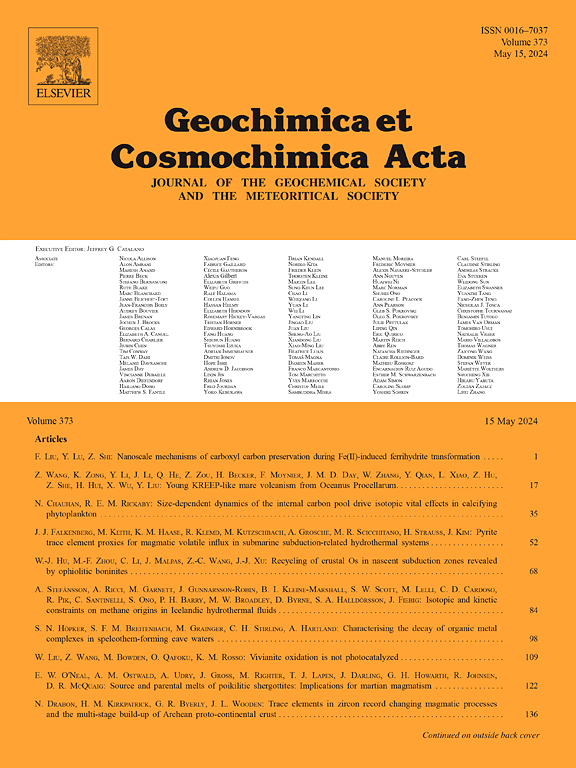Mn(II)-induced phase transformation of Mn(IV) oxide in seawater
IF 4.5
1区 地球科学
Q1 GEOCHEMISTRY & GEOPHYSICS
引用次数: 0
Abstract
Manganese (Mn) oxides are key components of oceanic and lacustrine Mn nodules and influence metal cycling through oxidation and adsorption processes. Layered Mn oxides (LMOs) are the most common minerals in these nodules and the immediate products of microbially mediated Mn(II) oxidation by O2. LMOs can transform into tunneled Mn oxides (TMOs), Mn oxyhydroxides (MnOOH), or Mn(II,III) phase (Mn3O4). LMOs often concur with Mn(II) in the environment and the adsorption and oxidation of Mn(II) by LMOs can greatly promote the transformation of LMOs to those phases. However, the Mn(II)-promoted transformation of LMOs in seawater—rich in various cations (300 mM Na+, 10 mM K+, 50 mM Ca2+, and 10 mM Mg2+) remains poorly understood. We examined the transformation of δ-MnO2 in artificial seawater (pH 8.2) under anoxic conditions with the Mn(II)/MnO2 ratio (r) ranging from 0.08 to 3.83. To assess the effect of ionic strength (IS), parallel experiments were conducted in a mixed 530 mM NaCl and 10 mM KCl solution (having seawater ionic strength but without Ca2+ and Mg2+) and in 100 mM NaCl solution as a control. At low r (0.08), δ-MnO2 transformed into triclinic birnessite and a 4 × 4 TMO in 100 mM NaCl solution, which, however, was suppressed in seawater due to strong interactions of Ca2+/Mg2+ with δ-MnO2. In the mixed 530 mM NaCl and 10 mM KCl solution (the same ionic strength as of seawater), the transformation occurred extensively but the products had lower crystallinity compared to in 100 mM NaCl solution. At the high Mn(II)/MnO2 ratios (0.5 ≤ r ≤ 3.83), δ-MnO2 transformed extensively into MnOOH phases and hausmannite (Mn3O4) in 100 mM NaCl solution. The seawater suppressed the transformation, but the suppression became weaker with increasing Mn(II)/MnO2 ratio. For example, the transformation was completely suppressed at r = 0.5 but essentially negligible at r = 3.83. The suppression at these high Mn(II)/MnO2 ratios was mainly ascribed to the influence of Ca2+ and Mg2+ rather than of the high IS, and the weaker suppression at the higher Mn(II)/MnO2 ratio suggests stronger competition of Mn(II) with Ca2+/Mg2+ for interacting with δ-MnO2. Moreover, the composition and crystallinity of the transformation products (i.e., the relative abundance of MnOOH (α, β, and γ) and Mn3O4) were influenced by both the high ionic strength and the presence of Ca2+ and Mg2+. Therefore, even though Ca2+ and Mg2+ concentrations are much lower than Na+ in seawater, their impacts on the transformation are dominant. Our study explains why MnOOH phases, hausmannite, and TMOs are less common than LMOs in oceanic environments, partially because seawater chemistry suppresses their formation. LMOs are the most reactive for metal adsorption and oxidation among all Mn oxides. Thus, the high stability of LMOs in an oceanic environment confers the high impacts of Mn oxides on metal cycling in the ocean.
Mn(II)诱导海水中Mn(IV)氧化物的相变
锰(Mn)氧化物是海洋和湖泊锰结核的主要成分,通过氧化和吸附过程影响金属循环。层状锰氧化物(LMOs)是这些结核中最常见的矿物,也是微生物介导的二氧化锰(Mn(II))氧化作用的直接产物。层锰氧化物可转化为隧道锰氧化物(TMOs)、锰氧氢氧化物(MnOOH)或锰(II,III)相(Mn3O4)。环境中的 LMO 常与 Mn(II)同时存在,LMO 对 Mn(II)的吸附和氧化可极大地促进 LMO 向这些相的转化。然而,在富含各种阳离子(300 mM Na+、10 mM K+、50 mM Ca2+和10 mM Mg2+)的海水中,Mn(II)促进LMOs转化的情况仍然鲜为人知。我们研究了人工海水(pH 值为 8.2)中δ-MnO2 在缺氧条件下的转化情况,Mn(II)/MnO2 的比率(r)从 0.08 到 3.83 不等。为评估离子强度(IS)的影响,在 530 mM NaCl 和 10 mM KCl 混合溶液(具有海水离子强度,但不含 Ca2+ 和 Mg2+)和 100 mM NaCl 溶液(作为对照)中进行了平行实验。当 r 值较低时(0.08),δ-MnO2 在 100 mM NaCl 溶液中转化为三菱菱锰矿和 4 × 4 TMO,但在海水中由于 Ca2+/Mg2+ 与δ-MnO2 的强相互作用而被抑制。在 530 mM NaCl 和 10 mM KCl 混合溶液(与海水的离子强度相同)中,发生了广泛的转化,但与 100 mM NaCl 溶液相比,产物的结晶度较低。当 Mn(II)/MnO2 的比率较高时(0.5 ≤ r ≤ 3.83),δ-MnO2 在 100 mM NaCl 溶液中广泛转化为 MnOOH 相和霞石(Mn3O4)。海水抑制了转化,但随着 Mn(II)/MnO2 比率的增加,抑制作用减弱。例如,在 r = 0.5 时,转化被完全抑制,但在 r = 3.83 时,转化基本上可以忽略不计。在这些高 Mn(II)/MnO2 比率下的抑制作用主要归因于 Ca2+ 和 Mg2+ 的影响,而不是高 IS 的影响;在较高 Mn(II)/MnO2 比率下的抑制作用较弱,这表明 Mn(II) 与 Ca2+/Mg2+ 在与δ-MnO2 相互作用方面的竞争更激烈。此外,转化产物的组成和结晶度(即 MnOOH(α、β 和 γ)和 Mn3O4 的相对丰度)受到高离子强度以及 Ca2+ 和 Mg2+ 存在的影响。因此,尽管海水中 Ca2+ 和 Mg2+ 的浓度远低于 Na+,但它们对转化的影响却是主要的。我们的研究解释了为什么在海洋环境中 MnOOH 相、霞石和 TMO 不如 LMO 常见,部分原因是海水化学抑制了它们的形成。在所有锰氧化物中,LMOs 的金属吸附和氧化活性最高。因此,LMOs 在海洋环境中的高稳定性使锰氧化物对海洋中的金属循环产生了很大影响。
本文章由计算机程序翻译,如有差异,请以英文原文为准。
求助全文
约1分钟内获得全文
求助全文
来源期刊

Geochimica et Cosmochimica Acta
地学-地球化学与地球物理
CiteScore
9.60
自引率
14.00%
发文量
437
审稿时长
6 months
期刊介绍:
Geochimica et Cosmochimica Acta publishes research papers in a wide range of subjects in terrestrial geochemistry, meteoritics, and planetary geochemistry. The scope of the journal includes:
1). Physical chemistry of gases, aqueous solutions, glasses, and crystalline solids
2). Igneous and metamorphic petrology
3). Chemical processes in the atmosphere, hydrosphere, biosphere, and lithosphere of the Earth
4). Organic geochemistry
5). Isotope geochemistry
6). Meteoritics and meteorite impacts
7). Lunar science; and
8). Planetary geochemistry.
 求助内容:
求助内容: 应助结果提醒方式:
应助结果提醒方式:


